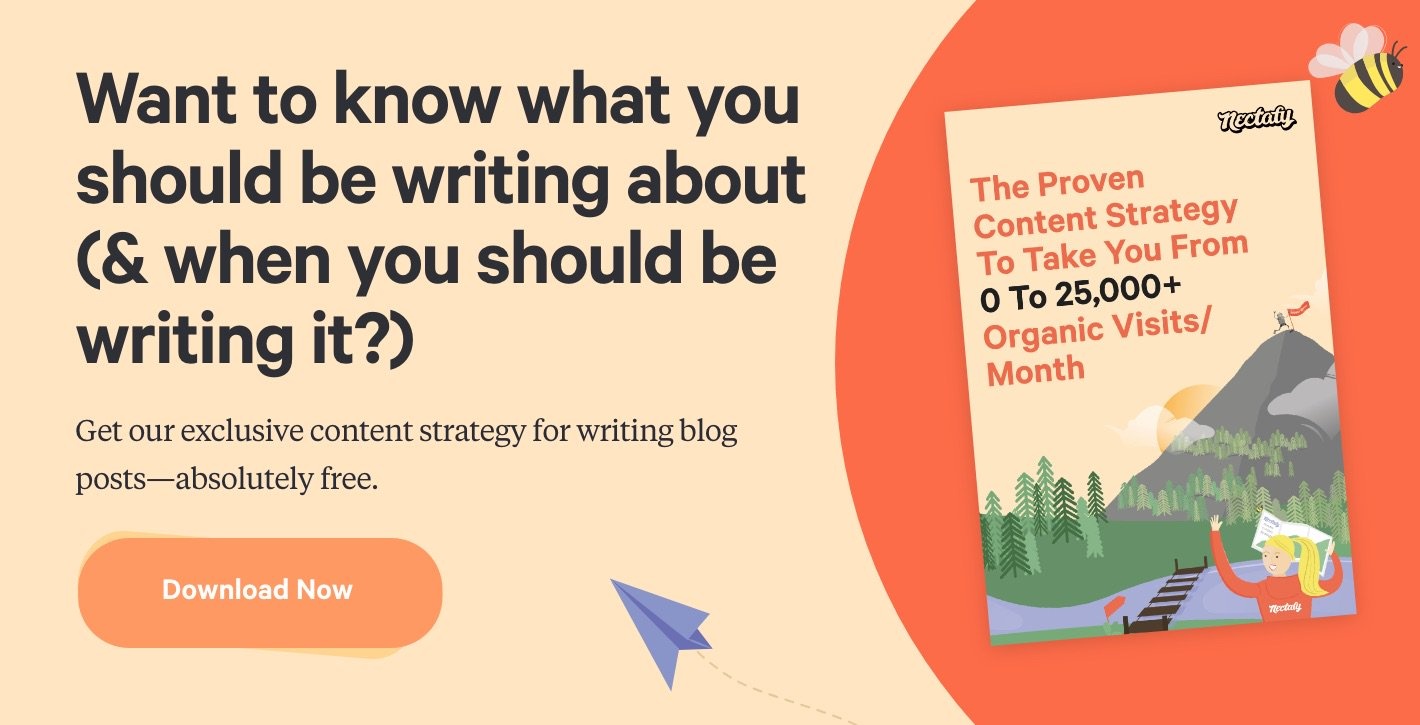6 Lead Generation Tactics That Took Our Clients From 50 To 500 Leads A Month


by Marisa Dube • 3 minute read • December 6, 2016

If your current lead generation strategy is bringing in 50 leads per month, you’re doing something right. In this case, we can assume that:
- The content you’re publishing is being read.
- The gated content you’re offering is enticing enough that visitors are completing forms to download it.
- Google sees that you have some kind of authority in your industry.
All in all, things are likely going pretty well on your website. But you can’t (and shouldn’t want to!) stop there—imagine making the leap from 50 to 500 leads a month! Then you will have hit a significant milestone in your inbound marketing. So, what can help catapult you from 50 to 500 leads? Here are the specific tactics we’ve implemented in our clients’ inbound marketing strategies to increase leads from 50 to 500 each month.
6 Lead Generation Tactics To Increase Your Monthly Leads
1. Write a comparison post.
A comparison post is simply an article that details the pros and cons of at least two things in your industry. When there are multiple products, companies, or methods available to accomplish something, people want to know the pros and the cons of choosing one, and ideally, they don’t want to spend hours doing the research themselves. One of our clients recently published two comparison posts that generated over 2,220 views each… in just six months. So, think of some things in your industry that people regularly compare, and detail the pros and cons of each option. (For even more detail, check out Henry’s article about comparison keywords.)
2. Write about key performance indicators (KPIs).
A KPI is a measurement that helps you determine how well you, your department, or your organization is performing and how that performance is helping accomplish company goals. Every business has buyer personas—by that, I mean the specific people your products and services are likely to help. Those buyer personas have KPIs they’re evaluated against to see how well they’re doing their job. (Their company may not call them “KPIs,” but every company, at some point, will compare an employee’s performance to what they expect of that employee.) Usually, your product or service will help your buyer personas perform better in their position—meaning, your product or service will help them excel with their KPIs. So, writing about your buyer persona’s KPIs will not only help them learn how they can be most valuable to their company, but it will also put what you have to offer in front of them—a product or service to make their job easier, help them perform better, and assist them in accomplishing company goals. (Here’s an example of a KPI post to give you some ideas: 29 Content Marketing KPIs You Should Be Tracking Already.) One other great reason to write about KPIs is because there isn’t much competition for KPI-related keywords—there aren’t a ton of people writing about them. So if you were to write content about KPIs, when people do search for something KPI-related, there’s a much higher chance of them discovering your content. For a client of ours, three out of their four top-performing blog posts are about KPIs. The top performing page is one of these articles—it attracts 35,000-40,000 views each month and has been linked to 95 times.
3. Post articles frequently and consistently.
All of our clients that saw significant growth in their lead generation were regularly posting articles. What do I mean by “regularly”? At a minimum, they were posting twice a week, which turns out to be about eight posts per month. It may seem like a lot, but Google likes it when you post a lot of high quality content and post it frequently. I recently learned something about baseball that, first of all, shocked me—but it also reinforced just how important it is to publish content frequently: When batting, the best baseball players typically hit the ball every one out of three times. (Maybe that doesn’t shock you, but I couldn’t believe that professional baseball players only successfully hit the ball 33% of the time.) But the more they play, the more likely they are to hit the ball. So let’s turn this back to you—the more content you publish, the more likely you are to hit on that one post your target audience loves and thereby doubles traffic to your website. One of our clients posted 91 articles over a span of seven months—that’s 13 articles each month! Writing high quality, helpful content that frequently is a lot of work, but the results are incredible. (One other incredible result: One of those articles has been linked to 388 times. Yes, you read that correctly!)
4. Frequently publish relevant, high quality offers.
Offers are pieces of content that you “offer” your prospects and leads for free, in exchange for information about themselves. Put simply, offers are content specifically created to generate leads for your company. (For a much more thorough explanation of offers, read What On Earth Are Inbound Marketing Offers?) Since offers help move your leads from the top of your sales funnel to the bottom, they should be a critical part of your content calendar. When we looked at our own data to see when our leads moved from 50 to 500, we noted that it took us about six months to reach 500 leads. During those six months, we pushed to publish eight offers—that works out to be about one offer every three weeks. Here’s the data to show how those offers impacted our lead generation: 1. White Paper Templates
- Views: 420
- Submissions: 165 (39.29% Conversion)
- New Contacts: 80 (19.05% Conversion Rate)
2. Sample Inbound Marketing Proposal
- Views: 631
- Submissions: 202 (32% Conversion)
- New Contacts: 111 (17.59% Conversion Rate)
3. The Beginner's Guide To Inbound Marketing
- Views: 405
- Submissions: 158 (39.01% Conversion)
- New Contacts: 51 (12.59% Conversion Rate)
4. How Our Company Put HubSpot To The Test
- Views: 115
- Submissions: 45 (39.13% Conversion)
- New Contacts: 11 (9.57% Conversion Rate)
5. How Nectafying Your Content Can Power Your Inbound Marketing
- Views: 123
- Submissions: 37 (30.08% Conversion)
- New Contacts: 10 (8.13% Conversion Rate)
6. 11 Tips To Survive The Crush Of Creating Content For Your Inbound Marketing
- Views: 70
- Submissions: 28 (40% Conversion)
- New Contacts: 5 (7.14% Conversion Rate)
7. 10 Reasons Not To Hire An Inbound Marketing Agency
- Views: 186
- Submissions: 55 (28.57% Conversion)
- New Contacts: 9 (4.84% Conversion Rate)
8. Inbound Marketing In A Nutshell
- Views: 115
- Submissions: 28 (24.35% Conversion)
- New Contacts: 2 (1.74% Conversion Rate)
Not all of those offers performed as well as we had hoped, but some of them performed far better than we imagined they would! It was a lot of work to create so many offers over the span of six months, but the hard work obviously paid off. The more persona-specific, downloadable content you make available, the higher your visitor-to-lead conversion rate will be.
5. Be smart about keyword strategy.
In inbound marketing, it’s imperative to have a keyword strategy in place—knowing what keywords your target audience uses and what keywords will best drive traffic to your website, and then writing content using those specific words and phrases. Before I move on, I need to take a minute to talk about keyword strategy: For your blog’s search engine optimization (SEO) strategy to work, there is something you need to consider—your website’s authority. If Google doesn’t find your website authoritative—meaning, it doesn’t “trust” that your website has valuable information—you won’t get ranked for any of the keywords you’re writing for. It’s as simple as it is frustrating, but it’s true. Henry has written extensively about this topic—it’s one reason your blog’s SEO doesn't work. To increase your website’s authority and to start ranking for some keywords, write about less competitive keywords. Because a keyword’s competition is based on how many other people are writing about that specific keyword, identify some keywords and keyword phrases your target audience uses that have a low competition score, and start writing really great content about those topics. You’re much more likely to get visits to your site this way. You can use Google AdWords to determine a keyword’s competition or any of the resources from this article. And, to make sure you’re using your low competition keyword phrases in the best way possible, be sure to read up on Uncle Henry’s SEO copy writing guidelines.
6. Create social posts to increase visits and links.
We consider “social posts” to be articles like:
- November’s Top 10 Inbound Marketing Must-Reads
- 59 Benefits Of Content Marketing From 50 Expert Marketers
- Treat Your Ears To 19 Of The Best Marketing Podcasts
They’re articles that feature someone else’s work, thoughts, company, etc. Since the people you’re featuring will most likely want to show others that they’ve been included in an article, they’ll share it. This both highlights their thought leadership in the industry and increases links and visits to your article. This is also a great way to boost lead generation while waiting for your organic website traffic to pick up. One of our clients wrote a social post like this, and it brought a ton of visits to their website. After publishing their social post:
- Visits to their site jumped from 1,800 to 5,600 in just six weeks.
- They gained 156 leads in three weeks.
- Three of their leads became customers within those same three weeks.
Social posts for the win!
The Takeaways
Here are our biggest takeaways:
- The more offers you have, the better. Write custom, downloadable content for every topic you write about on a regular basis (yes—everything). The more high quality offers you have, the higher your conversion rates will be.
- Write about less competitive keywords to increase your site’s authority and the quality of leads you receive. If your target audience is searching for something very specific and you have the solution, they will be very likely to give you their attention.
It’s worth mentioning that these lead generation tactics will work for a company seeing around 50 leads a month but not a brand new company. Going from zero leads to 500 (or even just 50) requires an entirely different set of tactics because, at the outset, Google and internet users have no idea who you are! If you find yourself in this boat, we’d love to give you a free evaluation and get you started on the right foot.
Has your company made the quantum leap to 500 leads a month? What helped you get there? I’d love to know!
